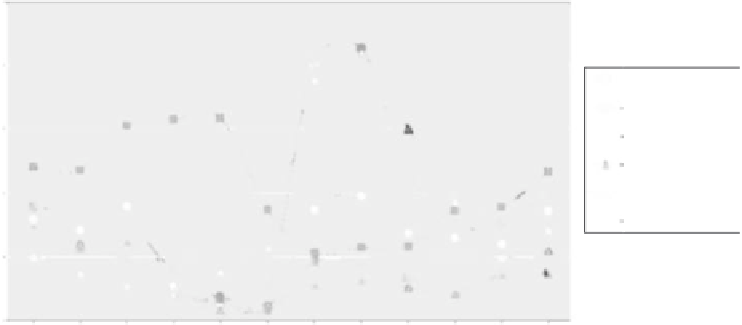Environmental Engineering Reference
In-Depth Information
2.5
2.0
Phoenix, AZ
Tu cson, AZ
Las Vegas, NV
Barstow, CA
Jornado, NM
Austin, NV
1.5
1.0
0.5
0
FIGURE 3.5
Mean monthly precipitation (inches) for selected stations in the four main southwestern U.S. desert regions:
Austin and Las Vegas, Nevada (Great Basin); Barstow, California (Mojave); Phoenix and Tucson, Arizona
(Sonoran); and the Jornada Experimental Range, New Mexico (Chihuahuan).
longitude 110°57′W) climate data illustrate conditions of the more lowland sites in the
region. Total annual precipitation at Phoenix and Tucson averages 7.57 and 11.16 in.,
respectively. Average annual maximum and minimum temperatures at Phoenix are 85.8°F
and 59.6°F, respectively; for Tucson, maximum and minimum temperatures are 83.4°F and
53.7°F. Note the pronounced onset of the summer monsoon rainfall pattern, an abrupt
change to a moist summer regime (Figure 3.5).
The Mojave Desert is a transition between the Sonoran and Great Basin Deserts
(Brady, this volume), but the Mojave Desert has a unique and characteristic bioform
in the Joshua tree (
Yucca brevifolia
). Because it is a transitional desert, it receives both
less winter and summer monsoon rains as illustrated by climate conditions at Barstow,
California (elevation. 2140 ft, latitude 34°54′N, longitude 117°1′W). Its precipitation is
only 4.4 in./year, with maximum and minimum temperature averages 80.2°F and 47.5°F,
respectively.
The Chihuahuan Desert occurs primarily in Mexico in the intermountain basin
in the Rocky Mountains and between the Sierra Madre Oriental and Sierra Madre
Occidental. It is at a higher elevation and receives more summer precipitation than
the Mojave and Sonoran Deserts. A characteristic form is the maguey or century plant
(
Agave
). Data from the Jornada Experimental Range of New Mexico (elevation 4270 ft,
latitude 32°37′N, longitude 106°44′W) is used to approximate climate conditions in this
desert area. Precipitation averages 10.0 in./year, with average maximum and minimum
temperatures of 76.7°F and 39.7°F, respectively. The three plots of the climate station
data for these deserts illustrate considerable variations of temperatures (over 20°F for
maximums, 30°F for the minimums) and moisture among the deserts (4-13 in. with much
more variability in higher elevations). The timing of precipitation is quite variable as a
function of rain shadow effects, impacts of Pacific storms, and exposure to the Southwest
summer monsoon. Major gradients of these conditions occur with elevation and location
in relation to the terrain of the areas within the region.


Search WWH ::

Custom Search